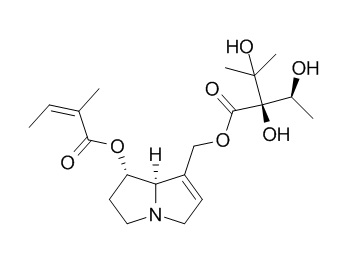Heliosupine
Heliosupine, heliosupine N-oxide, 3 ′-O-acetylheliosupine N-oxide,and 7-O- angeloylechinatine N-oxide show inhibition activity against the acetylcholinesterase(AChE), with IC50 0.53-0.60 mM.
Heliosupine can deter feeding by the polyphagous larvae of Spodoptera exigua.
Inquire / Order:
manager@chemfaces.com
Technical Inquiries:
service@chemfaces.com
Tel:
+86-27-84237783
Fax:
+86-27-84254680
Address:
1 Building, No. 83, CheCheng Rd., Wuhan Economic and Technological Development Zone, Wuhan, Hubei 430056, PRC
Providing storage is as stated on the product vial and the vial is kept tightly sealed, the product can be stored for up to
24 months(2-8C).
Wherever possible, you should prepare and use solutions on the same day. However, if you need to make up stock solutions in advance, we recommend that you store the solution as aliquots in tightly sealed vials at -20C. Generally, these will be useable for up to two weeks. Before use, and prior to opening the vial we recommend that you allow your product to equilibrate to room temperature for at least 1 hour.
Need more advice on solubility, usage and handling? Please email to: service@chemfaces.com
The packaging of the product may have turned upside down during transportation, resulting in the natural compounds adhering to the neck or cap of the vial. take the vial out of its packaging and gently shake to let the compounds fall to the bottom of the vial. for liquid products, centrifuge at 200-500 RPM to gather the liquid at the bottom of the vial. try to avoid loss or contamination during handling.
Horticulture, Environment, and Biotechnology2025, 66:729-739.
J Biochem Mol Toxicol.2017, 31(9)
Journal of Natural Remedies2024, 24(3):555�C575.
Appl. Sci.2020, 10(20), 7323.
World J.Traditional Chinese Med.2024, 10(3):370-382
Int J Mol Sci.2019, 20(16):E4015
Int J Mol Sci.2024, 25(20):11227.
Industrial Crops and Products2022, 188:115596.
Int J Mol Sci.2022, 23(11):6172.
Pharmaceuticals (Basel).2024, 17(6):727.
Related and Featured Products
Journal of Chemical Ecology February 1997, Volume 23, Issue 2, pp 399-416
Allelochemical Activities of Pyrrolizidine Alkaloids: Interactions with Neuroreceptors and Acetylcholine Related Enzymes[Reference:
WebLink]
METHODS AND RESULTS:
Thirteen pyrrolizidine alkaloids (PAs) 3′-acetylHeliosupine, echihumiline, echihumiline N-oxide, echimidine, Heliosupine, Heliosupine N-oxide, heliotrine, monocrotaline, pycnanthine, retronecine, riddeline, senecionine, and seneciphylline) were analyzed for their interactions with acetylcholine-related enzymes, such as acetylcholine esterase (AChE), butyrylcholinesterase (BChE), choline acetyl transferase (ChAT), and neuroreceptors, such as α1- and α2-adrenergic, nicotinergic (nACh), muscarinergic (mACh) and serotonin2 (5-HT2) receptors. Whereas most PAs did not affect the enzymes, they show significant binding activities to mACh and 5-HT2 receptors: Twelve PAs exhibited a 50% inhibition of the specific binding of the radioligand [3H]quinuclidinyl benzilate (QNB) at the mAChR, i.e., IC50 values were between 8.7 μM and 512.5 μM, and 10 PAs exerted a 50% inhibition of the specific binding of the radioligand [3H]ketanserine at the 5-HT2R with IC50 values between 23.2 μM and 608.6 μM. The most active compound was 3′-acetylHeliosupine, which was able to bind to all of the studied receptors with IC50 values in the range between 2.9 μM and 159.7 μM.
CONCLUSIONS:
The data imply that free PAs and PA N-oxides can affect several molecular targets: Besides long-term toxicity through DNA alkylation (by PA metabolites generated in the liver), liver and pneumotoxicity, neuroreceptors (among other molecular targets) may be modulated. The interference of PAs with neuronal signal transduction could mediate adverse physiological responses in herbivores and could thus contribute to chemical defense in plants and animals against herbivores and predators.
J. Chem. Ecol., 1995, 21(5):507-23.
Phytotoxic and antimicrobial activity of 5,7-dihydroxychromone from peanut shells[Pubmed:
24234013 ]
METHODS AND RESULTS:
A flavonoid decomposition product that is present in peanut (Arachis hypogaea) shells, 5,7-dihydroxychromone (DHC), was found to inhibit the radial growth of cultures of the soil pathogenic fungiRhizoctonia solani andSclerotium rolfsii with I50 (the concentrations of DHC required to inhibit growth 50%) values of 18 and 26μM, respectively. Radicle elongation of velvetleaf, corn, peanut, and wheat was inhibited by DHC with I50 values of 30, 50, 65 and 200μM, respectively. DHC had no effect on the growth ofBradyrhizobium sp. at 10μM in medium containing low (1.0 g/liter) mannitol as the carbon source, although the related flavones luteolin and chrysin each promoted bacterial growth at 10μM 48 hr after inoculation. When tested in high (10.0 g/liter) mannitol medium, DHC initially inhibited growth ofBradyrhizobium sp., but 120 hr after inoculation the growth of all treatments were similar.
CONCLUSIONS:
These results suggest a role for DHC released from peanut shells in suppressing pathogenic fungal infection and competing plant growth but not forBradyrhizobium growth promotion.
Nat. Prod. Res., 2016,Jan 6:1-8.
Pyrrolizidine alkaloids from Solenanthus lanatus DC. with acetylcholinesterase inhibitory activity.[Pubmed:
26735939 ]
METHODS AND RESULTS:
The whole plant ethanolic extract of Solenanthus lanatus was used for the isolation of acetylcholinesterase inhibitors. A new pyrrolizidine alkaloid, 7-O-angeloylechinatine N-oxide, 1, was isolated together with three known compounds of the same class (3'-O-acetylHeliosupine N-oxide, 2, Heliosupine N-oxide, 3, and Heliosupine, 4), by bioassay-guided approach. Their structures were elucidated by spectroscopic methods.
CONCLUSIONS:
All the isolated compounds showed inhibition activity against the AChE, with IC50 0.53-0.60 mM.



